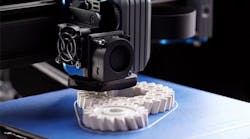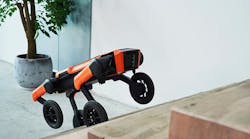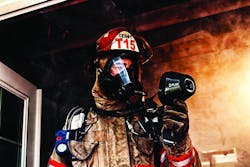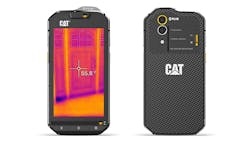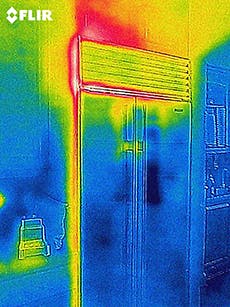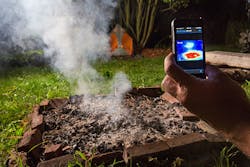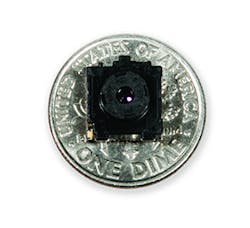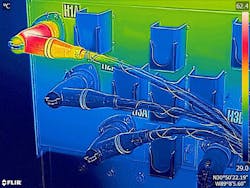Capt. Jason Ellison looked up at the four-story home in West Linn, Ore., a southern suburb of Portland, as bursts of wild red and orange flames thrashed out on a late October afternoon. Like most firefighters, the 16-year veteran says he thought there was still time to go offensive, meaning they would enter the home to beat back the three-alarm inferno.
“We feel confident we can do this,” said Ellison, who was responding from neighboring Clackamas, to the West Linn officer in charge.
Ellison and his partner bullied through thick smoke and crumbling hallways to the threshold of the 2nd floor living room. Soot billowed up like a wall to block the way; the firefighters had no idea what lay on the other side.
Capt. Jason Ellison relies on thermal imaging for fighting fires and emergency rescue. Photo by FLIR
Pointing a FLIR K50 thermal imaging camera (TIC) into the room revealed the floor had collapsed into the engulfed basement. Without being able to see beyond the smokey haze, the brave decision to rush in would have seemed quite reckless and tragic after the embers cooled and the firemen's bodies were recovered. Ellison’s team wisely held up.
“Because of that technology I was able to recognize and really see a crisp image of the building layout and show the firefighters the floor was compromised,” Ellison recalls of the camera, which has 320x240 pixel resolution. “It probably saved quite a few people from falling into that basement.”
Loss of life was prevented, as was loss of property. The house, though badly damaged, was saved. The $5,000 K50 proved it was worth every penny that day. You can’t put a price on a life, which is why firefighters spend upwards of $10,000 on thermal imaging equipment.
Thermography works by detecting variations in infrared radiation, developed for the military in the 1950s. If you’ve played any “Call of Duty” video game, you’ve probably been put down by a camper using the thermal scope on a sniper rifle. Other uses vary from detecting hot spots after a fire, inspecting buildings for energy leaks, preventative maintenance, and monitoring power utilities.
This video by drone manufacturer DJI really shows what thermal imaging can do:
Its potential is only limited by the user’s imagination, and until recently, budget.
That’s all changing, as thermal cameras are scaling down and costing less. For as effective a tool as it is, thermal imaging hasn’t hit the mainstream yet.
In June the technology may have found the vehicle to help it go supernova, That’s when the Cat S60 smartphone, the first ever to include a thermal imaging camera and this year’s hottest hybrid of commercial and industrial technology, becomes available in Europe and North America. It could blow away all preconceived notions about who can access the infrared spectrum and how. And it’s only $599.
Heat Vision
This smartphone, the combination of Caterpillar’s ruggedness and FLIR’s imaging prowess, is so super powered you’d think it came from Krypton: the strengthened die cast frame and 4.7-in. HD Gorilla Glass 4 screen allow it to withstand a 6-foot drop onto concrete; a lockdown switch for the speakers rigs it for submerged ops up to 16 ft for up to 60 min; and the FLIR Lepton longwave infrared imager gives the user the ability to read heat signatures with temperatures ranging from -20° to 150° C (within ±1-2° C) and a distance of 50 to 100 ft.
- FLIR thermal camera app with MSX technology
- 4.7-in HD multi-touch screen w/ auto wet finger & glove support
- Underwater 13-megapixel main camera with dual flash
- 5-mega pixel front-facing camera
- Support for 4G LTE networks
- Snapdragon 617 octa-core processor
- 32GB storage, 3GB RAM
- Android 6.0 Marshmallow
- 3,800mAh battery
- Accelerometer
- Proximity Sensor
- Compass
- 147.9 x 73.4 x 12.66 mm
This unfortunately doesn’t grant you the x-ray vision to see through walls, but the Lepton camera detects changes in a wall’s surface temperature, due to a blown hot water pipe or overheating circuit breaker, for example.
“It gives the impression of seeing through a wall,” explains Jeff Frank, FLIR Senior Vice President, Global Product Strategy. “Pipes, studs, and infestations do become visible because they are changing the temperature of the surface.”
And anyone has access to this new superpower just by pulling their phone out of their pocket or purse, or if you don’t care what people think of you, your belt holster.
Other FLIR features include: still image, panorama, and video capture; changeable heat palettes; temperature spot meter; and min, max, and average temperature data.
This isn’t the first foray into the commercial market. The progenitor to this, the $250 FLIR ONE, can attach to iPhones and Android-based phones, making them thermal imagers.
Frank calls the FLIR One’s launch in 2014 “an industry changing event.” The magic formula was implementing a conventional camera and thermal lens. Software called MSX extracts the outline of a window, captured by the regular lens, and overlays them on the thermal image.
“It adds a visual acuity to the scene that makes the apparent resolution of the thermal image much, much higher than it actually is,” says Frank.
It also came with a software developer kit, which allowed anyone to create their own apps leveraging the thermal capabilities.
“This added a new word to our vocabulary: fun,” Frank says.
A few of the more novel uses are “Find the ‘Hot’ Person in the Bar,” either a great pick-up tactic or way to get your face slapped, and the more kid-friendly thermal hide-and-go-seek.
Endless Possibilities
The hide-and-go-seek aspect might be fun for kids, but detecting body heat may also means life or death in emergency rescue operations.
On a late January night this year, Capt. Ellison, who also does emergency rescue, received word a pick-up truck sank into the frigid Collowash River near Mt. Hood. Using a maritime thermal imager, he found the soaking, scared girls on the opposite bank, where they had been for up to two hours. If they weren’t spotted, they could have died. With a range of 100 ft, the Cat S60 would be as effective for a daring water rescue, but it could also save your workplace.
A thermal image scan can quickly show if machines are operating correctly. Image by FLIR
Ellison often responds to electrical fault or fire alarm calls in the region’s industrial sector, covered in sprawling metal-clad buildings.
“These are large places, over a mile long,” Ellison says. “Just to get where loCation is takes a lot of time. If maintenance person is able to isolate or find where a hot spot is with this camera, they can flip the electric breaker before firefighters get there.”
A handheld thermal imager could also provide peace of mind. Even a dimly lit parking lot or dark alley couldn’t hide a rapist or mugger.
And for outdoorsy types, like Ellison, it could see more use than the visible light camera. His FLIR ONE is as important a camping tool as his canteen. The avid camper says the de facto night vision helps spot wild animals lurking in the dark, and to play high-tech Smokey Bear.
“You could look over campfire with thermal imager and be responsible and make sure we’re not potentially starting a forest fire,” he says.
Thermal imaging is a quick and easy way to ensure your campfire is completely out. Photo by FLIR
According to the U.S. Forest Service, people who don’t properly extinguish their campfires in public forests cause more than 1,100 wildfires a year, which leads to an annual loss of 122,000 acres.
Like the FLIR ONE, it uses MSX, but you don’t have to worry about forgetting it at home when you spot a Sasquatch on your late night hike.
“It’s the thermal camera that’s always with you: at a job site, hiking, camping, whatever,” says Mike Walters, FLIR’s Vice President of Micro Camera Products.
That accessibility has Walters, who worked for one of the first companies to put cameras on phones in 2003, thinking big.
“This has just as much potential for great things as the visible camera on the mobile phone,” he says. “It’s a pretty exciting time.”
When the Lepton camera reaches the commercial market, that’s when thermal imaging will probably permeate into more frivolous Millennial uses, such as Instagram and sexting. For now, it offers an immediate ROI for someone winterizing their home to a horse owner checking their mare’s legs for hot spots.
“If you have plumbing that’s backed up, you could run hot water and find the point of blockage, or look at circuit breaker for an overload condition,” Walters adds. “The possibilities are endless.”
It’s even spawned a new word Walters is quite fond of: the “Thermie,” a thermal selfie.
Whatever the application, FLIR, which was used to selling high-end cameras to huge companies, realized there was an entirely new consumer base for thermal.
“What’s happened is as the price has continually come down, we’re finding deeper and deeper penetration into every one of those market places,” Frank says. “No longer is the tech being purchased at $10,000 by plant maintenance engineers. Now house building inspectors and mom-and-pop type businesses are able to afford and deploy the technology.”
Doing Something Special
The FLIR ONE lightly paved the way for Cat S60, which like its giant yellow brethren, should bulldoze what any expects out of a rugged smartphone.
That’s the intentions of Bullitt, the company tasked with imbuing the Cat devices with their namesake’s toughness and commercial phones’ sophistication. Product manager Pete Cunningham has led the charge.When he started at Bullitt two years ago, the company had released the B15 for Caterpillar, a solid, brawny option for the job site, sharing the S60’s drop resistance and a touch screen that works when wet and with gloves. You could clad a commercial smartphone in an Otter Box and achieve roughly the same effect, though.
The B15 just didn’t have the “smarts” of its commercial peers in 2013: the battery capacity was a mediocre 2000mAh; 4G wasn’t an option; and the display was 4-in. and had WVGA, 800X480 resolution, last popular on popular commercial Samsung and LG types in 2011.
“We’ve tried to close the gap between the rugged space and the overall market,” Cunningham says.
Bullitt had progressively improved the Cat phone brand since the B15 with the S40 and S50, boasting a larger display, slimmer design and upgraded processor. Concessions were made; the drop resistance diminished by about 2 feet.
Instead of matching wits with other smartphone manufacturers, Bullitt took a different tack: teach their mobile device a new trade.
“Let’s do something special,” Cunningham mandated to his team. Bullitt had used the FLIR ONE and wanted to team up. During a sit down with FLIR, they learned there was a huge overlap in markets. Both brands appealed to plumbers, construction workers, and electricians.
“It was a natural fit,” Cunningham says. “The risk level was greatly reduced because of the synergy and customer base.”
The Lepton thermal camera is the smallest of its kind and 10 X less expensive than traditional thermal cameras. Photo courtesy FLIR
Once the Lepton micro-camera was perfected and integrated into the smartphone design, which included a bigger battery and metal casing, the two companies were ready for this year’s Mobile World Congress in Barcelona. A press release the Thursday before the February trade show teased the “World’s First Smartphone with Integrated Thermal Camera.”
“The frenzy that followed was unbelievable,” Cunningham remembers. “The stand was bombarded with people.”
And why wouldn’t it? It has the crossover appeal of Johnny Cash. City or country, young or old, the S60’s toughness, functionality and originality makes this one of the must tech gadgets of 2016.
He says it’s a “natural fit” for the industrial and DIY crowd, “but there’s going to be quite a big interest from early adopters and the boys-and-toys segment.”
“This is something that’s never been done before and I think that’s why it’s caught people’s imagination in the way it has.”
Thermal Expansion
Cunningham says that the SDK -- similar to the FLIR ONE version, though not compatible -- will be ready for the European launch in June; U.S. customers can order through the website, Catphones.com.
American channels should receive it four to six weeks later. Cunningham says it will run GSM, so if you have AT&T or TMobile, you could keep your carrier.
If you want to stay on CDMA (Sprint or Verizon), just be patient.
“We had major conversations with all the major carriers in the U.S.,” says Cunningham says.
The Cat S60 is the first , but won’t be the last to offer infrared.
“All of the major smartphone companies are aware of FLIR at this point,” Frank says. “And it’s not just cell phones, but the whole Internet of Things and wearables play into this world.”
The Cat S60 allows you to monitor power cables or perform preventative maintenance in between games of Candy Crush. Photo courtesy Catphones.com
Zero net energy could be achieved by through thermal sensors could control lighting and heating and cooling, Walters adds.
For all the uses mentioned, there are dozens more no one has thought of yet.
“That realization that it can be in your hand then generates the next level of creative thinking,” Walters says
Putting cameras on phones was directly responsible for the social media revolution, which in turn has affected how the world disseminates and receives information.
Now there’s a whole new spectrum to work with.
